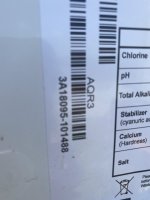Just added a ton of salt about a month ago... a bit too much. I think the Aquarite said 4200ppm
Last night I noticed the pool smelled gross. Solid lights for check salt (300-400) and check cell.
I have been battling TA and PH all summer, trying to keep the pump going to combat this insane texas heat. We leave the cover on and the temps get over 100. Take it off and chlorine drops.
Pull the cell today and sure enough, it's gunked up. Cleaned it out with MA, hooked everything back up.
Cell is now clean, but check salt is still solid, still reading at 300-400. Tried the reset/recalibrate procedure and no change.
No one local has the K-1766, so ordering off Amazon, won't be here until Sunday.
I have never seen salt drop that low, that fast before. Usually it's down around 2500-2700 at the end of the season from splash out, etc.
What do y'all think? T-cell was just replaced Feb 2021 after the infamous snowmageddon.
Last night I noticed the pool smelled gross. Solid lights for check salt (300-400) and check cell.
I have been battling TA and PH all summer, trying to keep the pump going to combat this insane texas heat. We leave the cover on and the temps get over 100. Take it off and chlorine drops.
Pull the cell today and sure enough, it's gunked up. Cleaned it out with MA, hooked everything back up.
Cell is now clean, but check salt is still solid, still reading at 300-400. Tried the reset/recalibrate procedure and no change.
No one local has the K-1766, so ordering off Amazon, won't be here until Sunday.
I have never seen salt drop that low, that fast before. Usually it's down around 2500-2700 at the end of the season from splash out, etc.
What do y'all think? T-cell was just replaced Feb 2021 after the infamous snowmageddon.


